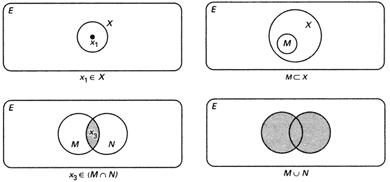Collections of objects or elements that have at least one characteristic in common. For example, the set X may consist of all the elements x1, x2, x3, etc. This is written
{x1, x2, x3,…} = X
. A specific element in a set is characterized by x1∈X, meaning x1 is a member of set X. A subset of set X, say M, would be written M⊂X, i.e. M is contained in X. If x3 is a member of both subsets M and N, then x3∈(MnN), i.e. x3 belongs to the intersection of M and N. M∪N means the union of M and N. For example, if M consists of {1, 4, 5, 8} and N consists of {2, 3, 4, 5} then MnN = {4, 5} and M∪N = {1, 2, 3, 4, 5, 8}
. In the diagram, the rectangle represents the universal set E, circles represent sets or subsets. These diagrams are called Venn diagrams , after John Venn (1834–1923), who invented them. 
Sets
- sidereal period
- siemens
- sievert
- sigma particle
- sign convention
- signal
- signal-to-noise ratio
- significant figures
- silicon chip
- simple harmonic motion
- simulation
- simultaneity
- sine wave
- single-sideband modulation
- sintering
- sinusoidal oscillator
- sinusoidal wave
- siphon
- skip distance
- sky wave
- slepton
- slow neutron
- slug
- smectic
- smelting